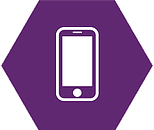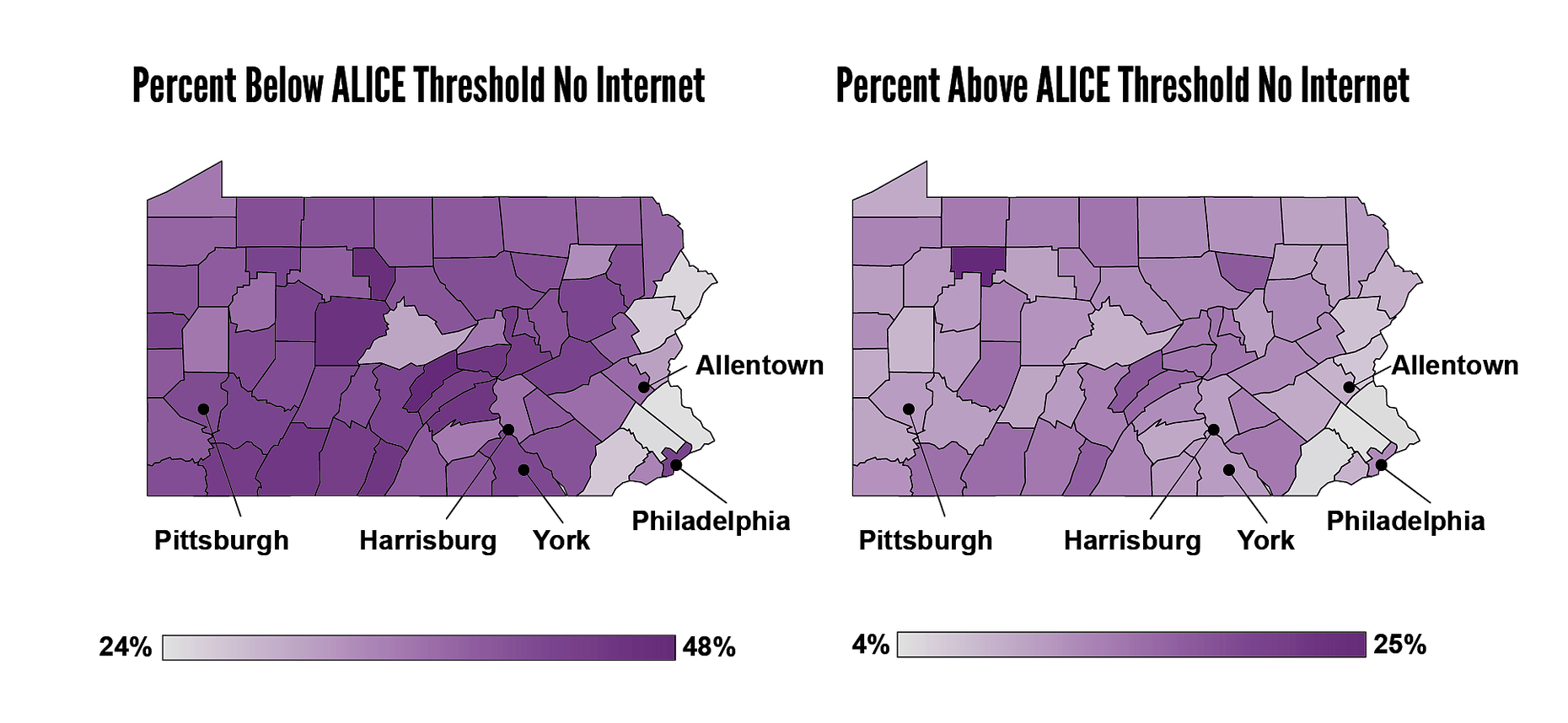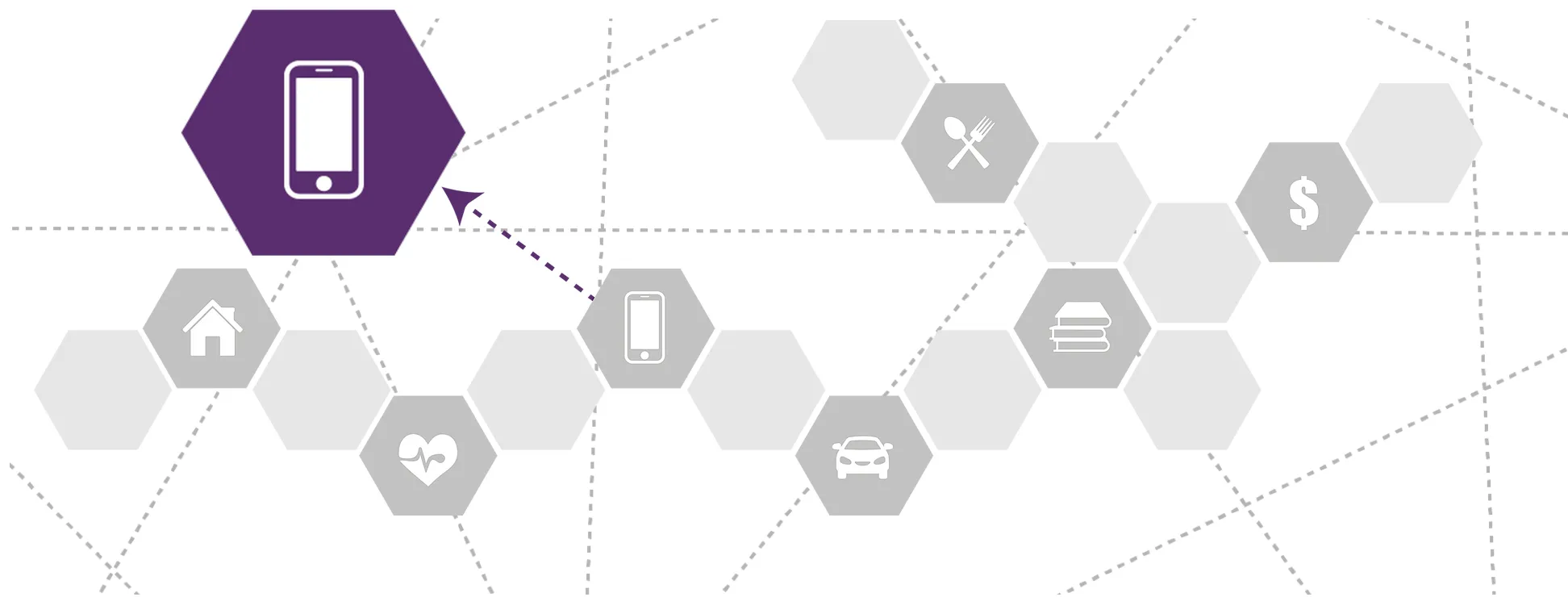
|
Housingclick to view |

|
Health Careclick to view |

|
Child Care and Educationclick to view |

|
Technologyclick to view |

|
Foodclick to view |

|
Taxesclick to view |

|
Transportationclick to view |
||
Introduction
Access to digital technology, especially reliable cellular and internet access, is no longer a luxury — it has become an essential feature of our everyday lives.1 Technology facilitates learning and connects us to information and resources, family and friends, work and school. People without access to the internet are at a significant disadvantage, so much so that the United Nations actively advocates equal access to the internet for all people.2
People access the internet in a variety of ways, including via smartphone, home broadband internet, and public internet access (i.e., shared computers or hotspots). Nationwide, 88 percent of people report using the internet every day.3 In 2016, 95 percent of American adults owned a cellphone (77 percent owned a smartphone), 73 percent had home broadband internet service, and 90 percent said they have used public internet access.4
ALICE and poverty-level households rely on basic technology for a variety of key functions, including:
Work/employment: Many people use their smartphones to access work schedules, contact employers or clients, and search and apply for jobs. A 2016 survey found that low-income smartphone owners are much more likely to use their phones as part of a job search.5
-
In a 2015 survey, 43 percent of people reported using a smartphone to look up information about a job, and 18 percent used their smartphone to submit a job application.6
- 58 percent of people earning less than $30,000 per year used a smartphone to look up job information, compared to 32 percent of people with incomes of $75,000 and higher per year.
- 32 percent of people earning less than $30,000 per year used a smartphone to submit a job application, compared to 7 percent of people with incomes of $75,000 and higher per year.7
Researching and applying for services/benefits: Many government and non-profit social services for low-income households can be researched, applied for, and monitored online. In 2015, 40 percent of people surveyed used smartphones to look up government services or information.8
Child care and education: For children, internet access is directly tied to educational outcomes. Nationwide, about 70 percent of teachers assign homework that requires internet access, but almost one in five students can’t reliably do their homework due to lower rates of home internet access (a disparity that is even more pronounced for Black and Hispanic students).9 For parents, reliable internet access is important for navigating child care and school schedules, selecting classes and activities, and accessing grades and progress reports. And for adults seeking continued education, internet access can connect them to a growing number of online degree programs and job training opportunities.10
Health care: In 2015, 62 percent of Americans used smartphones to get information about a health condition.11 The use of remote health care services (such as internet-based health education, scheduling, and virtual doctor visits) is also on the rise and will be increasingly important for health care access, particularly for those who receive employer-based health benefits. In a 2017 survey of 148 employers (providing coverage to 15 million people), 96 percent said they will offer remote health care services within the next year.12
Despite the importance of these functions, there is still a notable “digital divide” in access to and use of technology across different demographic groups. Use and access vary by age, rural location, and level of education. Some of the sharpest disparities, however, are by income:13
- The most common form of technology used by adults in the U.S. is a smartphone, with more than seven in 10 adults using a smartphone in 2016. And almost all households with income above $100,000 (97 percent) have smartphone access.
- The gap in access to home broadband is much greater: Just over half of households with income below $30,000 (56 percent) have access, compared to 81 percent of those with income between $30,000 and $99,999 and 94 percent of those with income over $100,000. ALICE households have less access to broadband than those above the ALICE Threshold, as exemplified in the figures below for the state of Pennsylvania 2017.
Broadband Internet Access by Income, Pennsylvania Counties, 2017

Source: American Community Survey. (2017). 2017; 1-, 3-, and 5-Year estimates.
Across all users and groups, secure internet connections are also increasingly important. Secure connections at home can be costly to install and an expense that an ALICE household may not be able to afford, making home computers more vulnerable to viruses and hacking. Outside of the home, use of public Wi-Fi puts personal data, passwords, financial information, pictures, and videos at risk.14
Sources
1
Smith, A. (2017, January 12). Record shares of Americans now own smartphones, have home broadband. Pew Research Center. Retrieved from https://www.pewresearch.org/fact-tank/2017/01/12/evolution-of-technology/
2
United Nations Human Rights Council. (2016, June 27). The promotion, protection and enjoyment of human rights on the internet. Retrieved from https://www.article19.org/data/files/Internet_Statement_Adopted.pdf
3
Pew Research Center. (2019, June 12). Mobile fact sheet. Retrieved from https://www.pewinternet.org/fact-sheet/mobile/
4
Smith, A. (2017, January 12). Record shares of Americans now own smartphones, have home broadband. Pew Research Center. Retrieved from https://www.pewresearch.org/fact-tank/2017/01/12/evolution-of-technology/
Pew Research Center. (2019, June 12). Mobile fact sheet. Retrieved from https://www.pewinternet.org/fact-sheet/mobile/
Norton. (2017). Norton cyber security insights report. Symantec. Retrieved from https://us.norton.com/cyber-security-insights-2017
5
Anderson, M. (2019, May 7). Digital divide persists even as lower-income Americans make gains in tech adoption. Pew Research Center. Retrieved from https://www.pewresearch.org/fact-tank/2017/03/22/digital-divide-persists-even-as-lower-income-americans-make-gains-in-tech-adoption/
6
Smith, A. (2015, April 1). Chapter two: U.S. smartphone use in 2015. Pew Research Center. Retrieved from https://www.pewinternet.org/2015/04/01/chapter-two-usage-and-attitudes-toward-smartphones/#job%20seeking
7
Anderson, M. (2019, May 7). Digital divide persists even as lower-income Americans make gains in tech adoption. Pew Research Center. Retrieved from https://www.pewresearch.org/fact-tank/2017/03/22/digital-divide-persists-even-as-lower-income-americans-make-gains-in-tech-adoption/
8
Smith, A. (2015, April 1). Chapter two: U.S. smartphone use in 2015. Pew Research Center. Retrieved from https://www.pewinternet.org/2015/04/01/chapter-two-usage-and-attitudes-toward-smartphones/#job%20seeking
9
Anderson, M., & Perrin, A. (2018, October 26). Nearly one-in-five teens can’t always finish their homework because of the digital divide. Retrieved from https://www.pewresearch.org/fact-tank/2018/10/26/nearly-one-in-five-teens-cant-always-finish-their-homework-because-of-the-digital-divide/
10
Anderson, M., & Perrin, A. (2018, October 26). Nearly one-in-five teens can’t always finish their homework because of the digital divide. Retrieved from https://www.pewresearch.org/fact-tank/2018/10/26/nearly-one-in-five-teens-cant-always-finish-their-homework-because-of-the-digital-divide/
Beltran, D. O., Das, K. K., & Fairlie, R. W. (2008, November). Home computers and educational outcomes. Board of Governors of the Federal Reserve System. Retrieved from https://www.federalreserve.gov/pubs/ifdp/2008/958/ifdp958.pdf
11
Smith, A. (2015, April 1). Chapter two: U.S. smartphone use in 2015. Pew Research Center. Retrieved from https://www.pewinternet.org/2015/04/01/chapter-two-usage-and-attitudes-toward-smartphones/#job%20seeking
12
National Business Group on Health. (n.d.). Annual best practices in health care employer survey 2016. Retrieved from https://www.businessgrouphealth.org/topics/engagement/telehealth/
13
Pew Research Center. (2019, June 12). Mobile fact sheet. Retrieved from https://www.pewinternet.org/fact-sheet/mobile/
Anderson, M. (2019, May 7). Digital divide persists even as lower-income Americans make gains in tech adoption. Pew Research Center. Retrieved from https://www.pewresearch.org/fact-tank/2017/03/22/digital-divide-persists-even-as-lower-income-americans-make-gains-in-tech-adoption/
Martin, M.J.R. (2019). Deconstructing the digital divide: Identifying the supply and demand factors that drive internet subscription rates (SEHSD Working Paper No. 2019-15). U.S. Census Bureau, Social Economic, and Housing Statistics Division (SEHSD). Retrieved from https://www.census.gov/content/dam/Census/library/working-papers/2019/demo/sehsd-wp2019-15.pdf
14
Pew Research Center. (2019, June 12). Mobile fact sheet. Retrieved from https://www.pewinternet.org/fact-sheet/mobile/
Bencie, L. (2017, May 3). Why you really need to stop using public Wi-Fi. Harvard Business Review. Retrieved from https://hbr.org/2017/05/why-you-really-need-to-stop-using-public-wi-f

